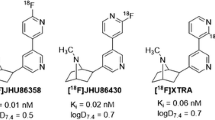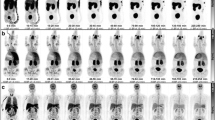Abstract
Recently, 5-[123I]iodo-3-(2(S)-azetidinylmethoxy)pyridine ([123I]5IA) was developed as a ligand for imaging the nicotinic acetylcholine receptor (nAChR) in human brain using single photon emission computed tomography (SPECT). In the present study, the toxicity and radiation absorbed dose of [123I]5IA were investigated.
Behavior and physiological parameters were examined in mice and rats after administration of 5IA. There were no changes in these parameters in animals administered 1 μg/kg of 5IA or less, indicating that the no observed effect level (NOEL) of 5IA was 1 μg/kg. [123I]5IA was then administered to healthy human subjects and serial whole-body images were acquired over 24 hr. Initially, high levels of radioactivity were observed in the liver and urinary bladder and moderate levels in the lungs, kidneys, and brain. Whole brain activity at 1 hr was 4.6 ± 0.4% of the injected dose and this value gradually decreased with time. The majority (~75%) of the radioactivity was excreted in urine within 24 hr, and less than 1% remained in all organs tested. The biological half-life of [123I]5IA averaged 7.2 ± 4.0 hr. Based on the biodistribution data, radiation absorbed doses were estimated using MIRDOSE 3.1 software with the dynamic bladder model and the ICRP gastrointestinal (GI) tract model. Consequently, the effective dose equivalent was estimated to be 30 ± 1.4 μSv/MBq, which is an acceptable radiation burden. Having determined the safety of this compound, we performed SPECT imaging in a healthy human subject using 171 MBq of [123I]5IA. SPECT images clearly revealed a cerebral distribution of radioactivity that was consistent with the known distribution of central nAChRs in humans. These results suggest that [123I]5IA is a promising ligand for imaging nAChRs in humans, with an acceptable dosimetry and pharmacological safety at the dose required for adequate SPECT imaging.
Similar content being viewed by others
References
Gotti C, Fornasari D, Clementi F. Human neuronal nicotinic receptors.Prog Neurobiol 1997; 53:199–237.
Paterson D, Nordberg A. Neuronal nicotinic receptors in the human brain.Prog Neurobiol 2000; 61:75–111.
Akaike A, Tamura Y, Yokota T, Shimohama S, Kimura J. Nicotine-induced protection of cultured cortical neurons against N-methyl-D-aspartate receptor-mediated glutamate cytotoxicity.Brain Res 1994; 644:181–187.
Holladay MW, Bai H, Li Y, Lin NH, Daanen JF, Ryther KB, et al. Structure-activity studies related to ABT-594, a potent nonopioid analgesic agent: effect of pyridine and azetidine ring substitutions on nicotinic acetylcholine receptor binding affinity and analgesic activity in mice.Bioorg Med Chem Lett 1998; 8:2797–2802.
Burghaus L, Schutz U, Krempel U, de Vos RA, Jansen Steur EN, Wevers A, et al. Quantitative assessment of nicotinic acetylcholine receptor proteins in the cerebral cortex of Alzheimer patients.Brain Res Mol Brain Res 2000; 76:385–388.
Shimohama S, Taniguchi T, Fujiwara M, Kameyama M. Changes in nicotinic and muscarinic cholinergic receptors in Alzheimer-type dementia.J Neurochem 1986; 46:288–293.
Burghaus L, Schutz U, Krempel U, Lindstrom J, Schroder H. Loss of nicotinic acetylcholine receptor subunits alpha4 and alpha7 in the cerebral cortex of Parkinson patients.Parkinsonism Relat Disord 2003; 9:243–246.
Guan ZZ, Nordberg A, Mousavi M, Rinne JO, Hellstrom-Lindahl E. Selective changes in the levels of nicotinic acetylcholine receptor protein and of corresponding mRNA species in the brains of patients with Parkinson’s disease.Brain Res 2002; 956:358–366.
Chefer SI, Horti AG, Lee KS, Koren AO, Jones DW, Gorey JG, et al.In vivo imaging of brain nicotinic acetylcholine receptors with 5-[l23I]iodo-A-85380 using single photon emission computed tomography.Life Sci 1998; 63:PL355–360.
Fujita M, Tamagnan G, Zoghbi SS, Al-Tikriti MS, Baldwin RM, Seibyl JP, et al. Measurement of alpha4beta2 nicotinic acetylcholine receptors with [123I]5-I-A-85380 SPECT.J Nucl Med 2000; 41:1552–1560.
Musachio JL, Scheffel U, Finley PA, Zhan Y, Mochizuki T, Wagner HN Jr, et al. 5-[I-125/123]Iodo-3(2(5)-azetidinyl-methoxy)pyridine, a radioiodinated analog of A-85380 forin vivo studies of central nicotinic acetylcholine receptors.Life Sci 1998; 62:PL351–357.
Musachio JL, Villemagne VL, Scheffel UA, Dannais RF, Dogan AS, Yokoi F, et al. Synthesis of an 1-123 analog of A-85380 and preliminary SPECT imaging of nicotinic receptors in baboon.Nucl Med Biol 1999; 26:201–207.
Saji H, Ogawa M, Ueda M, lida Y, Magata Y, Tominaga A, et al. Evaluation of radioiodinated 5-iodo-3-(2(5)-azetidinylmethoxy)pyridine as a ligand for SPECT investigations of brain nicotinic acetylcholine receptors.Ann Nucl Med 2002; 16:189–200.
United States Government. Single dose acute toxicity testing for Pharmaceuticals.Federal Register 1996; 61:43934–43935.
Cloutier RJ, Smith SA, Watson EE, Snyder WS, Warner GG. Dose to the fetus from radionuclides in the bladder.Health Phys 1973; 25:147–161.
International Commission on Radiological Protection.Limits for intakes of radionuclides by workers. New York; Pergamon Press, 1979.
Stabin MG. MIRDOSE: personal computer software for internal dose assessment in nuclear medicine.J Nucl Med 1996; 37:538–546.
Volle RL, Koelle GB. Ganglionic stimulating and blocking agents. In:The Pharmacological Basis of Therapeutics, Goodman LS, Gilman A (eds), New York; The Macmillan Company, 1970: 585–600.
Molina PE, Ding YS, Carroll FI, Liang F, Volkow ND, Pappas N, et al. Fluoro-norchloroepibatidine: preclinical assessment of acute toxicity.Nucl Med Biol 1997; 24:743–747.
Stauderman KA, Mahaffy LS, Akong M, Velicelebi G, Chavez-Noriega LE, Crona JH, et al. Characterization of human recombinant neuronal nicotinic acetylcholine receptor subunit combinations alpha2beta4, alpha3beta4 and alpha4beta4 stably expressed in HEK293 cells.J Pharmacol Exp Ther 1998; 284:777–789.
Xiao Y, Meyer EL, Thompson JM, Surin A, Wroblewski J, Kellar KJ. Rat alpha3/beta4 subtype of neuronal nicotinic acetylcholine receptor stably expressed in a transfected cell line: pharmacology of ligand binding and function.Mol Pharmacol 1998; 54:322–333.
Sihver W, Nordberg A, Langstrom B, Mukhin AG, Koren AO, Kimes AS, et al. Development of ligands forin vivo imaging of cerebral nicotinic receptors.Behav Brain Res 2000; 113:143–157.
Fujita M, Seibyl JP, Vaupel DB, Tamagnan G, Early M, Zoghbi SS, et al. Whole-body biodistribution, radiation absorbed dose, and brain SPET imaging with [123I]5-I-A-85380 in healthy human subjects.Eur J Nucl Med Mol Imaging 2002; 29:183–190.
van Dyck CH, Seibyl JP, Stubbs JB, Zoghbi S, Wisniewski G, Baldwin RM, et al. Human biodistribution and dosimetry of the SPECT D2 dopamine receptor radioligand [123I]IBF.Nucl Med Biol 1996; 23:9–16.
Versijpt J, Dumont F, Thierens H, Jansen H, De Vos F, Siegers G, et al. Biodistribution and dosimetry of [123I]iodo-PK 11195: a potential agent for SPET imaging of the peripheral benzodiazepine receptor.Eur J Nucl Med 2000; 27:1326–1333.
Beekhuis H. Population radiation absorbed dose from nuclear medicine procedures in The Netherlands.Health Phys 1988; 54:287–291.
Author information
Authors and Affiliations
Corresponding author
Rights and permissions
About this article
Cite this article
Ueda, M., Iida, Y., Mukai, T. et al. 5-[123I]Iodo-A-85380: assessment of pharmacological safety, radiation dosimetry and SPECT imaging of brain nicotinic receptors in healthy human subjects. Ann Nucl Med 18, 337–344 (2004). https://doi.org/10.1007/BF02984473
Received:
Accepted:
Issue Date:
DOI: https://doi.org/10.1007/BF02984473




